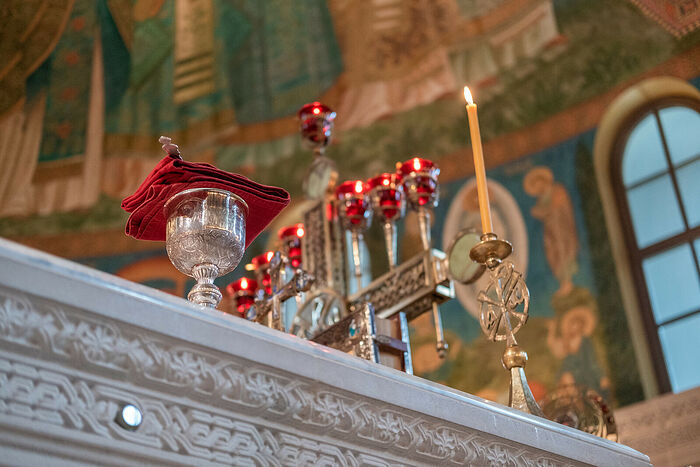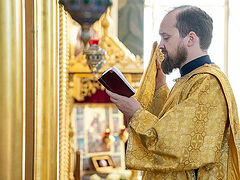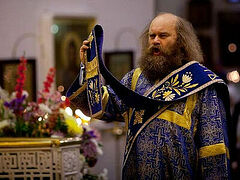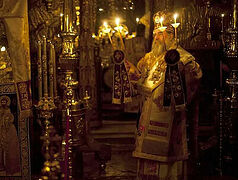With God’s help, we continue to analyze the text of the Divine Liturgy, as much as our strength allows. Today we will consider this petition from the Litany of Peace: “For this holy house, and for them that with faith, reverence, and fear of God enter herein, let us pray to the Lord.”1
Thus, we pray for this holy church, called here a holy house; after all, a church is the house of God—a place where God resides. Of course, we must understand that God isn’t limited to any space. God doesn’t live in man-made churches, doesn’t settle in houses and buildings, no matter how large, beautiful, and magnificent they may be. There’s nothing in creation that could contain God within itself. God created everything and He is beyond everything. So then why do we say that God dwells in a church?
God dwells in a church by His uncreated grace, for the Divine Sacraments are celebrated in church. The Sacraments of the Church are celebrated there: The people of God, having gathered in this holy place, are themselves the Church. At the same time, the house of God is consecrated by a special rite in which a bishop reads some remarkable prayers for the consecration of the altar and the entire church. It’s worth saying a few words about this rite.
As the Old Testament tells us, in ancient times, man served God by building stone altars and sacrificing animals on them (cf., for example, Gen. 8:20, 12:7-8). This is how they worshiped before the Mosaic Law. After God gave the Law to Moses, the Tabernacle of Meeting appeared, where they kept the relics of the Israelite people: the tablets of the Covenant, the vessel with manna, Aaron’s budded rod, and some other sacred items. When the people of God, Israel, entered into the Promised Land, King Solomon built a temple according to the desire of the whole of the people. He built the Temple as directed by God. It was precisely in this place, in the Temple, that the Jews, and only them, served the true God. When our Savior Jesus Christ suffered the Crucifixion, the Mosaic Law was abolished, and the Jewish people lost the Kingdom of God (cf. Mt. 21:43). Then God established His people, His nation—the nation of the Church, the nation of Christians, surpassing all earthly nations and peoples.
After the Resurrection and Ascension of Christ, in the first years of the existence of the Christian Church, Christians continued going to Solomon’s Temple together with the Jews. There they studied the Mosaic Law, sang Psalms and praised God, and at the end of the Temple service, they would gather in the home of one of the faithful and celebrate the Divine Eucharist, communing of the Body and Blood of Christ. However, this situation didn’t last very long. Christianity began to receive other peoples too, who were forbidden to enter Solomon’s Temple. Therefore, Christians were forced to separate from Jewish worship. At first they would gather in homes, where they would pray, study the Law of God, and serve the Divine Eucharist.
Very soon the Church entered the period of persecution and was considered illegal for nearly three centuries. A huge number of Christians suffered at this time. According to the martyrologies, there were at least about 11 million martyrs in the first three centuries of persecutions. In just one day, 20,000 Christians were burned alive in Nicomedia. What did Christians do when they were persecuted? They gathered in tombs, in cemeteries. Whoever’s been to Rome has seen the catacombs—Christian sepulchers and at the same time, places of prayerful gatherings. We also have catacombs here in Cyprus, for example, in Paphos (the Catacombs of St. Solomonia). They would bury Christian martyrs in the catacombs, and then the faithful would celebrate the Eucharist over their graves. We have to have an altar to celebrate the Eucharist, and in the catacombs, the tombstones were used as altars.
The first three centuries passed, and St. Constantine the Great ascended the imperial throne and ended the persecutions. The Church came out of the catacombs. What did it begin to do? To build churches over the tombs of the martyrs. If you go to the Monastery of St. Heraclius,2 you’ll see the saint’s tomb under the church. This is exactly how the matyria were built in ancient times—churches over the graves of the martyrs. Christians built churches everywhere. That’s when there arose the rite for consecrating a place where the ministry to God would be performed—the rite of consecrating the holy altar.
Today, in addition to Holy Chrism, we also use the relics of martyrs in the consecration of the altar in a newly-built church, thereby following the ancient Church tradition of building churches on the relics and blood of the martyrs. The bishop who celebrates the consecration (I must say that only a hierarch has the right to consecrate a church and altar) brings a small reliquary with a particle of the relics of holy martyrs with him. Entering the church, the bishop enters the altar and places the reliquary on the site reserved for it. A candle is lit before the relics. Vespers is served, with Matins the next day. When the time for the consecration itself comes,3 then after reading three preliminary prayers, the bishop picks up the diskos with the reliquary, and together with all the clergy and faithful, walks in procession thrice around the church. Besides the relics, they also carry the Gospel, a cross, fans, banners, and candles in the procession. In performing this procession with the singing of troparia and the reading of prayers, we thereby sanctify the space of the church of God, and this place is sanctified, beautified, and receives a grace-filled covering, and is henceforth dedicated to God.
After going around the church three times, the clergy and faithful enter inside. A special space is prepared beforehand in the center part of the altar, where the holy relics will be placed. If any of you have been at a consecration, you must have noticed that before putting relics in space in the altar, the bishop puts a list of the names of the founders of the church there, that is, those who built this church by donating funds for its construction.
You might say: “Okay, and what about us? We don’t have a lot of money. We were only able to donate a little bit for the construction. Won’t our names be commemorated anywhere?” To this I say the following: God judges according to the disposition of everyone. You remember how the Gospel talks about a widow who put just two mites into the Temple treasury, about which Christ said that she put in more than everyone else, although others put in thousands. The poor woman had only two mites, and she gave them to the Temple without reservation. Others could have tens of thousands of coins, but they gave only one thousand to the Temple. Who donated all they had? She who had only two coins. Thus, the Lord judges by other standards.
Thus, the bishop places the list of the names of the benefactors of the church in the central space in the altar, and then he places the holy relics there. Immediately before placing the box with the relics in this space, the bishop pours holy Chrism on the relics three times, and three times exclaims: “Eternal memory to the benefactors of this holy church.” Thus, we pray for the founders of the church. At every service, whether Vespers, Matins, or Liturgy, the Church remembers its benefactors: “Again we pray for the blessed and ever memorable founders of this holy house.” It’s a great honor for someone to become the founder of a holy church! This is why our ancestors built churches big and small, whatever they could, with such zeal. It was a great blessing both for them and their families, and for all Christians.
The box with the holy relics, placed into the space in the altar, is covered over with a special paste consisting of wax, mastic, and other aromatic oils. This space is then filled with the wax-mastic and covered with a lid. Then the altar is anointed with holy Chrism, after which icons of the four Evangelists are attached to the edges of the altar. Then we adorn the altar with cloths: a white cloth below, symbolizing the burial shroud of Christ, and red above, serving as a symbol of the Blood of Christ given to us in the Holy Eucharist. Thus an altar and church of God are consecrated.
Passing by a church, we bless ourselves with the Sign of the Cross. Why do we do this? Because we understand that the church is holy, that it’s the house of God, and that there are relics of holy martyrs inside. There are holy relics in the altar of every church. Unfortunately, the Turks know about this tradition. Therefore, when they seized Northern Cyprus, destroying churches on the occupied territory, they broke altars and threw away their holy relics. But some relics were saved: In fleeing from the occupiers and leaving their hometowns, our fellow Cypriots removed the relics from the churches and took them with them.
When there isn’t a consecrated church, then we use the so-called antimens to celebrate the Liturgy. What is it? It’s a rectangular cloth with an icon of the placing of the Lord Jesus Christ into the tomb (like the Plaschanitsa). Along the edges of the antimens it reads: “This Divine and sacred altar is consecrated for the celebration of the Divine and sacred rites upon it in every place of the dominion of our Lord and God and Savior Jesus Christ.” The antimens is consecrated by the bishop during the consecration of the church and is anointed with holy Chrism. And particles of holy relics are placed into the antimens, just as into the altar.
Unlike the altar, the antimens can be moved anywhere you want. You can’t serve the Divine Liturgy without it. Of course, if a church is consecrated, then the antimens isn’t necessary.4 But if I go somewhere to serve Liturgy, in this hall, for example, I can’t do it without an antimens. If there isn’t a consecrated altar somewhere, then you have to have antimens. With antimens, I can celebrate the Liturgy under the open sky, on a boat, in an auditorium, “in every place of His dominion.” Wherever a priest is, if he has an antimens, he can celebrate the Liturgy.




